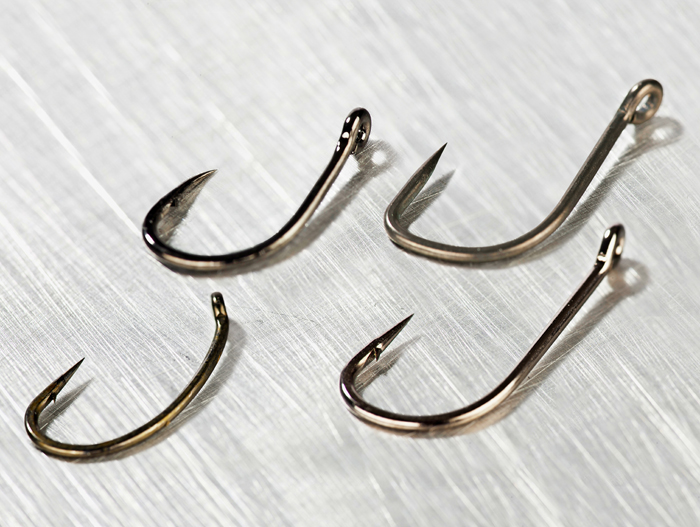Guide to carp hooks
Together, these four main hook types will cover every carp-angling situation you’re likely to encounter. Learn their strengths to ensure you pick the right one for the task in hand.
The wide gape
Perhaps the most classic looking carp pattern, a wide-gape hook is a good all rounder.
They are great for use with bottom baits but come into their own with buoyant baits, either in the form of pop-ups or on the surface.
In the latter scenario, wide-gape hooks are chosen due to their high strength-to-size ratio.
As explained in the panel (right), the large gape (the distance between the point and the shank) improves the chances of the hook catching hold as the fish expells your hookbait.
At a glance
Use for: Surface/pop-up rigs
Try these: Fox SSBPs
The curved shank
Whereas the other hooks on this page have a straight backbone, these hooks are curved in the shank.
Popular in the fly-fishing world, carp anglers realised their coarse potential many years ago.
The curved shank is considered to make these hooks harder for the fish to get rid of.
Some more advanced set-ups, such as the KD rig, rely on the hooking mechanics of curved-shank hooks.
At a glance
Use for: Clued-up fish
Try: Korda Kaptor Kurvs
The stiff rigger
The difference with this hook is the pronounced out-turned eye, which makes this pattern perfect for use with stiff materials like fluorocarbons.
Though such materials have improved in recent years, fluorocarbons and monfilaments were traditionally found to weaken considerably when tied to an inturned-eyed hook with a knotless knot.
These days, chod rigs are all the rage and these hooks are the only sensible choice for such a presentation.
At a glance
Use for: Chod rigs
Try: Nash Chod Twisters
The long shank
Long and thin, these hooks are perfectly suited for use with bottom baits.
If you are fishing with particle baits such as sweetcorn or tiger nuts, then these hooks are the perfect accompaniment.
The long shank can push your bait too far away from the point of the hook, but trapping the hair on the bend with a piece of tubing will eliminate this problem.
At a glance
Use for: Bottom baits
Try: Avid LSKs
HOOK BASICS
EYE
Traditional eyed hooks have always been associated with big-fish anglers such as carpers due to their strength, though these days the rules are less clear cut. Hooks with out-turned eyes are designed for mono and stiff materials, and those with in-turned eyes are traditionally best when using braided hair rigs.
POINT
The type of hookpoint you choose depends mainly on the bottom being fished over. Straight points are best for weedy swims as they catch weed less eaisly, beaked points for gravelly bottoms as they are harder to blunt and long points for carp with firmer mouths.
GAPE
Wide gape hooks lend themselves to large baits such as big pellets and boilies, while those with a narrower gape were traditionally suited to side-hook small baits like maggots and casters.
SHANK
Short-shanked hooks are a better choice for baits that are hair rigged tight to the back of hooks, while long shanks are preferred by by carpers looking to increase the hooking angle.
FINISH
Most hooks used to have a silver finish (a). However, nowadays many anglers are obsessed with making their hooks blend in with the lakebed – hence the emergence of low-glare options in grey (b) and other colours such as brown (c).






